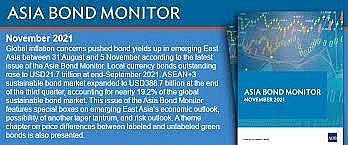VCN – Emerging East Asia’s bond market grew 3.4% in the third quarter to Ú$21.7 trillion, although rising global inflation and a shift in the United States (US) monetary stance weakened regional financial conditions, according to the latest issue of the Asia Bond Monitor.
 |
Bond yields rose, currencies weakened, and risk premiums edged up amid increased global inflation and the US Federal Reserve’s announcement that it would limit bond purchases starting in November, according to the report, released today by the Asian Development Bank (ADB).
ADB Acting Chief Economist Joseph Zveglich, Jr said: “The encouraging macroeconomic outlook and accommodative policy stances are supporting the region’s financial conditions. However, central banks in the region may find they need to be less accommodative to keep inflation in check and to keep in step with US monetary policy changes. That said, the chance of another ‘taper tantrum’ is limited as the direction of the Federal Reserve’s stance is clearly communicated and the region’s economic fundamentals remain strong.”
Emerging East Asia comprises the People’s Republic of China (PRC); Hong Kong, China; Indonesia; the Republic of Korea; Malaysia; the Philippines; Singapore; Thailand; and Viet Nam.
Government bonds remained the dominant segment, increasing 3.9% from the previous quarter to US$13.6 trillion. The bond markets of the Association of Southeast Asian Nations (ASEAN) members – many of which suffered from the coronavirus disease’s (COVID-19) Delta variant outbreak – grew 14.4% from a year earlier to US$1.9 trillion in the third quarter, compared with 12.6% and 7.6% growth in the PRC and the Republic of Korea, respectively.
Growth in Viet Nam’s local currency bond market accelerated to 8.1% from the previous quarter, increasing the market size to US$83.6 billion. Annual growth slowed to 23.5%. The overall bond stock expansion was attributed to the recovery of government bonds from a contraction last quarter and corporate bonds sustaining strong growth.
Government bonds increased 4.2% from the previous quarter to US$62.1 billion at the end of September. Vibrant issuance in the corporate sector propelled the 21.5% quarterly growth of the segment, although this was slower than in the second quarter. Total corporate bonds outstanding grew to US$21.4 billion.
ASEAN bond markets showed sound market capacity during the pandemic, evident in low bond yields amid rapid market expansion. Domestic financial institutions, particularly banks, anchored bond market functioning. At the same time, a few ASEAN central banks facilitated market liquidity and government financing via asset purchasing programs. Mid- and long-term bonds account for a majority of outstanding bonds in ASEAN bond markets, implying a relatively stable financing structure.
Sustainable bond markets in the ASEAN region plus the PRC; Hong Kong, China; Japan; and the Republic of Korea totaled US$388.7 billion, remaining the largest regional sustainable bond market after Europe and accounting for 19.2% of global sustainable bond markets at the end of September. Green, social, and sustainability bonds accounted for 71.6%, 13.0%, and 15.3% of the region’s sustainable bonds outstanding, respectively. As this regional market develops, the issuer base is also diversifying from just the financial sector to other business sectors.
The latest issue of the Asia Bond Monitor analyzes the price and yield differences between labeled and unlabeled green bonds. Recent research finds that investors would pay more for labeled or certified green bonds that have better information disclosure and lower reputational risk.
 | Government bond auction under the multi-price method piloted VCN – The Treasury Management Department (State Treasury) in collaboration with the Hanoi Stock Exchange (HNX) held … |
The report also discusses how the Delta variant outbreak and uneven vaccination progress slowed and caused divergences in regional economic recovery; the likelihood of a “taper tantrum” repeat; and risks to the current outlook, including continuing pandemic-induced uncertainty, slow vaccination rollouts in developing countries, and supply chain disruptions.
By Huyen Trang
